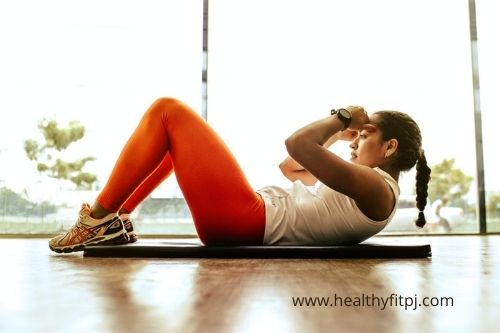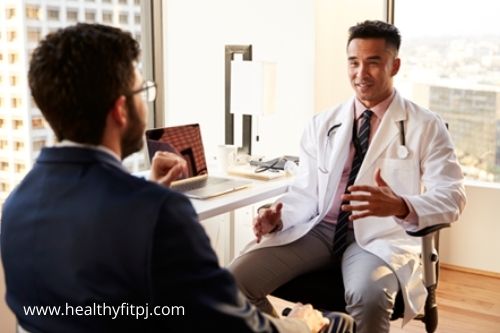Many men might experience puffy nipples or inflamed; it is another common type of gynecomastia. Puffy nipples in men are common and they are the result of enlarged breast glands.
There are several factors that can lead to puffy nipples in men, including certain exercises, having excess chest fat and hormonal imbalances. They can be uncomfortable, and rarely indicate a medical emergency.
In most cases, you may minimize puffy nipples by making changes into your diet and exercise related. Making these small changes can help to reduce body fat and strengthen your chest.
If changes in diet and exercise aren’t so effective, surgery may be necessary to get desired results and reduce swelling and return your nipples to their previous state. So, read the article till the end to learn what are the causes of puffy nipples and how to get rid of puffy nipples in men.
- Also Read : How to Get Rid of Man Boobs – 5 Best Exercise
- Also Read : Top 9 Muscular Endurance Exercises and Get Fighting Shape
Table of Contents
What are Puffy Nipples?
Puffy nipples occur when the male nipples or areola project outward that can cause the nipples to look puffy or pointy. Men and women can have puffy nipples, but most commonly a puffy nipple found among men.
The puffy nipples are most often found in teenagers going through puberty and this is a time in breast development. You can fix it just by changing in diet and exercise routine, and even by nipple reduction surgery.
What Causes Puffy Nipples in Men?
Puffy nipples are often caused by genetics and hormonal changes, there are also some external factors including your diet, steroid use and medications, excess fat, low testosterone level or gynecomastia, and more. Here are some causes of puffy nipples in men.
01. Hormonal Imbalances
Every man has both type of sex hormones; testosterone and estrogen, and usually males have higher levels of testosterone.
If males have higher-than-normal estrogen levels that can cause the mammary glands to grow, lead in a medical condition called gynecomastia. So, if you bring your estrogen levels back to the normal level, breast and nipple swelling usually go away from you.
02. Certain Exercises
A person may develop swollen or puffy nipples after jogging or running for extended periods of time. The motion of running or jogging can cause friction between the fabric of the clothing and the skin of the nipple, that may lead to chafing. The result will be getting puffy nipples.
03. Excess Body Fat
Having excess fat in the body can affect the appearance and shape of the nipples and breast. If a man has excess fat tissue in the chest (breasts), which can make the nipples appear a bit longer than usual. Being overweight in men can also cause hormonal imbalances.
In a small study 2017, found that men with overweight or more body fat showed lower testosterone levels and higher estrogen levels. So, reducing body fat can return your hormonal level and may reduce swelling nipples and breast size.
04. Steroid Use
Using steroids like anabolic steroids can lead to hormonal imbalances.
Small case study 2010, shows that two males regularly used anabolic steroids, both experienced gynecomastia, and the swelling of the nipple or puffy nipples.
5 Ways to Get Rid of Puffy Nipple
Here are 5 ways to get rid of puffy nipples or swelling nipples.
01. Changing Your Diet
What you eat regularly plays an important role in how you look and how you feel. In some cases, the puffy nipples are the results of excess fat and too much of estrogen level.
If you want to start changing the way your chest looks, then make a few changes in diet and eat more estrogen-decreasing foods. Eating mindful foods also help you get fit and stay in shape.
If you want to lower body fat, then try a low-fat diet,
- Consume more of fruits and vegetables
- Consume higher fiber foods like bran, nuts, seeds and legumes
- Limit eating processed foods and added sugars
- Avoid soy products and grains
- Eat fewer of refined carbohydrates like white bread, pasta and pastries
If you’re changing in diet, kindly talk with your doctor first, because they can provide you with more detailed information about what you should avoid and what you should eat, and also, they recommend a better diet that is suited to your individual needs.
If you think that you may have hormonal imbalances and might want to avoid estrogen rich foods and increase consumption of testosterone rich foods.
Here are testosterone-rich foods, which you can try adding to your diet:
- Tune
- Ginger
- Low-fat milk
- Beans
- Garlic
- Fish and shellfish
- Onion
- Olive oil
- Egg yolks
- Beef
- Blueberries
- Oysters
- Macadamia nuts
- Cruciferous vegetables
Foods to avoid because these are the foods, which are estrogen rich foods:
- Lima beans
- Soy products
- Split peas
- Clover sprouts
- Alfalfa
- Pinto beans
You also need to limit alcohol consumption because too much alcohol can affect fertility.
02. Exercising

Exercises are also a vital part of shaping up your chest, doing certain chest exercises can also help to reduce nipple puffiness and swelling breasts in men. Here are some exercises which are specifically designed to tighten and tone your pectoral and chest muscles.
Some popular exercises include:
- Dips
- Barbell bench press
- Chest press
- Bodyweight flyes
- Low cable flyes
- Push-ups
- Incline bench cable fly
- Overhead presses
- Bent-forward cable crossovers
You can use these exercises to create a good workout routine. Remember to use more than one chest exercises, because they can target multiple muscles.
If you’re a beginner to weight lifting, you can perform exercises with fewer sets and more repetitions using light weight. For example, try doing between one to three sets of 8 to 12 repetitions.
Over time, increase the number of sets, or increase the weights and decrease the number of sets. Try to do a 20 to 30 minutes chest workout two or three times a week and rotate different types of chest exercises so that they can work slightly different muscles.
Ideally, your exercises will be balanced with some type of full-body exercises, and aim to add some aerobic exercises into your workout routine, so you can get a full body workout.
Some aerobic exercises include:
- Cycling
- Swimming
- Jumping rope
- Running
- Jogging
You can try to do 15 to 20 minutes of cardio exercises before and after your weight training and do 40 to 60 minutes of cardio on the days between your weight training, so they can help to build up your chest muscles by doing a full-body exercise.
03. Supplements
Herbal or natural supplements may help to reduce puffy nipples and boost testosterone levels. Some of these herbal supplements include:
- Ginger: it is a flowering root that contains numerous antioxidants like zingerone, flavonoids and gingerols. Ginger can help to reduce puffy nipples that may occur as a result of hormonal imbalances.
- Turmeric: it is also another root plant that contains a powerful compound called curcumin, that can help to increase your testosterone levels.
- Fenugreek: it is a common culinary herb that is rich in fiber and numerous minerals and vitamins, including vitamins A, B-6, B-12, and D. Which can significantly increase testosterone levels and also improve sperm count, mood and mental alertness.
- Ashwagandha
- Milk thistle
- Red clover
- Passionflower
- Dandelion
However, some of the supplements can cause unpleasant side effects or have dangerous interactions with prescription medications. For this reason, you should talk with a doctor before you start herbal supplements, and they can advise you and recommend you a specific product of supplements.
04. Surgery
If you aren’t getting the result by changing the diet and exercises, then surgery may be required to treat breast conditions. It is very important to talk with a doctor so they can help you with a better treatment plan that can suit your needs and they may also discuss surgery.
Below are some procedures that are often used to treat gynecomastia and also used to treat puffy nipples.
- Liposuction: this surgery is used to remove breast fat by using a small tube called a cannula. Which is connected to a high-pressure vacuum. It required six to eight weeks to recover.
- Mastectomy: this surgery involves removing your breast gland tissue or excess breast fat. It will take four to five weeks to recover.
- Tissue excision: this surgery used to remove glandular breast tissue and excess skin to correct gynecomastia. The surgeon may reduce the size of the nipples for a more natural appearance. It takes up to three weeks to recover.
05. Get Enough Sleep
This is very important to get enough sleep every night, at least 7 to 8 hours. However, if you really want to get rid of puffy nipples, then sleep is vital because it helps your body recharge, recuperate and rejuvenate.
When to Talk a doctor

If you’re noticing that unwanted puffiness around your nipples or your nipples are appearing larger than usual, then you need to speak with a doctor. So, your doctor can help with creating a treatment plan.
Some causes of gynecomastia and breast swelling can be serious, and can lead to underlying conditions. So, it is important to speak with a professional doctor.
FAQs on Puffy Nipples
-
How Do You Know If You Have Puffy Nipples?
Puffy nipples may appear around your nipples and they can be larger than the usual, and nipple mount formed away from the normal curve of the chest. Anyone who is experiencing this kind of condition, then needs to talk with a doctor.
-
What Does it Mean If I Have Puffy Nipples?
Puffy nipples indicate that a person is experiencing hormonal imbalance or a hormonal change. Certain steroid and medications use can also result in puffy nipples. If you have too much body fat that could lead in puffy nipples.
Puffy nipples are rarely the sign of underlying conditions and any serious medical conditions.
Conclusion
Puffy nipples are results of hormonal imbalance, steroid use, excess body fat and certain exercises. It is commonly found in men, but you can get rid of it by changing your diet and exercises, or getting surgery.
Although, breast-related conditions can be uncomfortable or embarrassing. So, it is important to speak with a doctor about any symptoms they may be experiencing.
Hopefully, you like this article, if you have any questions and suggestions kindly put them in the comment box below.
You’ll also like:
